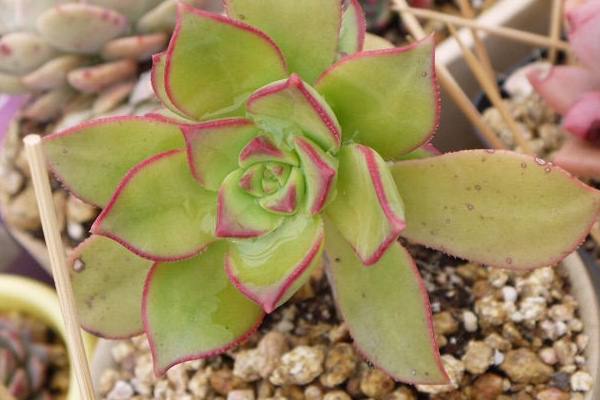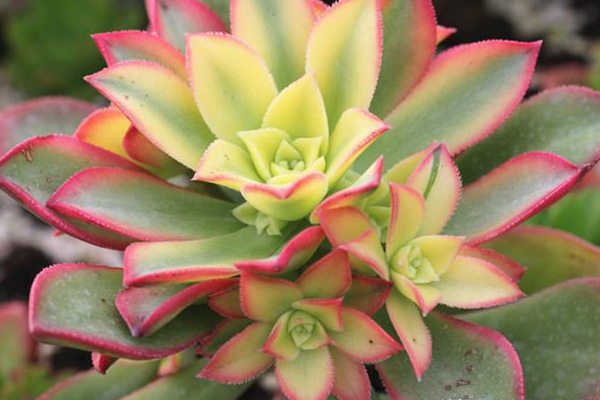Aeonium Haworthii (Pinwheel) Succulent Grow & Care Guide
Written by Iris
Dec 15 2021

Aeonium Haworthii (Pinwheel) is a succulent plant, native to the Canary Islands in the Atlantic Ocean. Aeonium Haworthii has the habit of growing in cold seasons and dormant in high temperature in summer. During the dormant period, Aeonium Haworthii care should be taken to control the amount of watering and avoid direct sunlight. How to grow and care for Aeonium Haworthii (Pinwheel) has become a hot topic for succulent lovers. The following article will share the care and propagation tips of Aeonium Haworthii.


During growth seasons (spring, summer), watering should be regular, about once or twice a month, but controlled, to make sure the roots don't rot. In autumn, gradually reduce watering until winter, when once-monthly watering will suffice.
The best way is to cut by hand by breaking the stems gently. Be sure to keep 3 to 5 leaves on each branch, otherwise pruning may weaken it too much.
Where to Grow Aeonium HaworthiiHow to Grow Aeonium HaworthiiAeonium Haworthii Seeds Propagation Aeonium Haworthii Stem Cutting PropagationAeonium Haworthii Leaf Cutting PropagationAeonium Haworthii Offsets PropagationHow to Care for Aeonium HaworthiiAeonium Haworthii Light CareAeonium Haworthii Soil CareAeonium Haworthii Water CareAeonium Haworthii Temperature & Humidity CareAeonium Haworthii Fertilizer CareAeonium Haworthii Pruning CareAeonium Haworthii Pests & Diseases Care
Where to Grow Aeonium Haworthii
Whether you're growing them indoors or out, aeoniums thrive in bright, dry conditions. aeonium haworthii store water in their thick, fleshy leaves and need very little water, which means they do best in very well drained soil or in a gravel garden. The foliage is tough enough to withstand windy conditions, making them good for coastal gardens. If you don't have the right conditions in your garden, grow them in pots, either on their own or with drought-tolerant bedding plants, such as pelargoniums. If growing aeoniums indoors, give them a bright spot – they can take some direct sunshine.
How to Grow Aeonium Haworthii
Aeonium Haworthii Seeds Propagation
This succulent Aeonium Haworthii is a slow grower so even if it can be propagated by its seeds, this method is not recommended. To propagate from the seeds, plant the seeds in a well-draining soil mixture. This method can be used outdoors. In cooler areas, indoor propagating is recommended.Aeonium Haworthii Stem Cutting Propagation
You can propagate aeonium Haworthii easily by taking cuttings, which should root in a few weeks. Take cuttings in spring. Select young, slender shoots as propagation material. These will root more easily and have more vigour than older, thicker shoots.- Take cuttings of healthy shoots with stems around 10cm long. Hold the stem in your hand to steady it and cut it off flush with the main stem so you don't leave a snag. Use sharp secateurs to make a clean cut.
- Place the cuttings on their side and leave them somewhere dry and warm for a few days until the wound has calloused (see cutting on left of picture). This will reduce the chance of the cutting developing rot later on.
- Insert cuttings into deep 5cm or 8cm pots of soil-based potting compost mixed with equal parts grit. Firm the compost at the base of the cutting and make sure that at least half of the stem is above compost level.
- Sprinkle a 1cm layer of crushed grit or perlite over the compost surface after gently watering each cutting. Give the pot a shake to leave a level surface. This layer helps keep the stem dry by improving drainage.
Aeonium Haworthii Leaf Cutting Propagation
When propagating Aeonium Haworthii with leaves. You should get a leave carefully from the mother plant. It should be a healthy leave that has no part left on the stem. In this way, the propagation will work. Before replanting, wait for a few days to allow it to callous. Use well-draining soil for your new succulent plant. Don’t forget to water when the soil dries out.Aeonium Haworthii Offsets Propagation
Aeonium Haworthii propagates from offsets. To be able to propagate from the mother plant, you might wait several years for the main plant to produce an offset. To start this process, use a sharp knife and remove an offset from the main plant. When you remove the offset, clean the extra soil from it. Before replanting, wait for a few days to allow it to callous. Use well-draining soil for your new succulent plant. Don’t forget to water when the soil dries out.
How to Care for Aeonium Haworthii
Aeonium Haworthii Light Care
Unlike some succulents, Aeonium Haworthii does not like really hot and dry weather. If Kiwi verde is exposed to extreme heat, it’s leaves will curl to help prevent too much water loss. If you bring your Aeonium Haworthii outside in the summer months, grow it a shady spot to encourage growth. The plant prefers morning sun or very bright, indirect light.Aeonium Haworthii Soil Care
A sandy loam or regular potting mix amended with perlite is better than a mix specifically for succulents and cacti since Aeoniums need some moisture. If grown in garden beds with dense soil, it may be necessary to amend with peat moss to improve soil porosity.Aeonium Haworthii Water Care
Pinwheel succulent dislikes humidity, and its water needs are pretty limited — it stores everything it needs inside its thick leaves!During growth seasons (spring, summer), watering should be regular, about once or twice a month, but controlled, to make sure the roots don't rot. In autumn, gradually reduce watering until winter, when once-monthly watering will suffice.
Aeonium Haworthii Temperature & Humidity Care
These plants prefer a Mediterranean climate—not too hot, not too cold, not too dry. Most Aeonium varieties are only hardy in USDA Zones 9 to 11. Growing Aeonium Haworthii in moist shade will keep them growing in high heat, but their true growth season is winter to spring, when temperatures are cool (65 to 75 degrees Fahrenheit) and damp. They may go dormant in summer and do not require excessive watering, except in excessively dry conditions. In extreme heat, their leaves will curl to prevent excessive water loss.Aeonium Haworthii Fertilizer Care
Aeonium haworthii is applied to the nutrient supplement every half month. When we grow and care for Aeonium haworthii, when applying the fertilizer, the thin liquid fertilizer should not splash on the leaves, otherwise it will cause falling leaves.Aeonium Haworthii Pruning Care
When some branches of Aeonium Haworthii do not have a good look or are too old, you can prune, ideally in spring, after flowering.The best way is to cut by hand by breaking the stems gently. Be sure to keep 3 to 5 leaves on each branch, otherwise pruning may weaken it too much.
Aeonium Haworthii Pests & Diseases Care
Aeonium haworthii is easy to cause red spider damage when it is dry and poorly ventilated in the growing period. When we grow and care for Aeonium haworthii, after the occurrence, spraying 40% oxidized dimethoate emulsion agent 1000-2000 times liquid for prevention and control. Root rot is a very common disease caused by overwatering your plant. Unfortunately, root rot goes unnoticed until it is too late. Soggy leaves and stems, yellowing, wilting, and black roots are all signs of root rot.
Latest Updated
- Benefits of Bugleweed - 7 Science-backed Health Benefits
- Bugleweed Dangers & Side Effects - Is It Poisonous?
- How to Plant Evergreen Trees - What You Should Know
- When to Plant Evergreens - Grow Guide for Evergreen Trees
- 12 Wonderful Evergreen Shrubs for Your Garden
- 12 Popular Evergreen Plants with Pictures for Beginners
- When And How To Prune A Lilac Bush Like a Pro
- How to Grow & Care for Lilac Vine (Hardenbergia Violacea)
- Japanese Lilac Tree (Syringa Reticulata) Care & Propagation Guide
- Shumard Oak Pros and Cons - What to Know
Popular Articles
- Winter maintenance of Antirrhinum Majus
- How to Grow Terminalia Mantaly Tree
- How to Grow and Care for Crossostephium Chinense
- How to grow Antirrhinum Majus in spring
- Peristeria Elata (Dove Orchid) Profile: Info & Care Guide
- Underwatered Snake Plant (Sansevieria Trifasciata) - Signs And How To Fix
- How to Care for Brazilian Jasmine Plant (Mandevilla Sanderi)
- How to Grow & Care for Graptopetalum Purple Delight in Summer
- Rosa Chinensis (China Rose): Plant Growing & Care Tips
- How to Care for Baby Sun Rose (Aptenia Cordifolia)